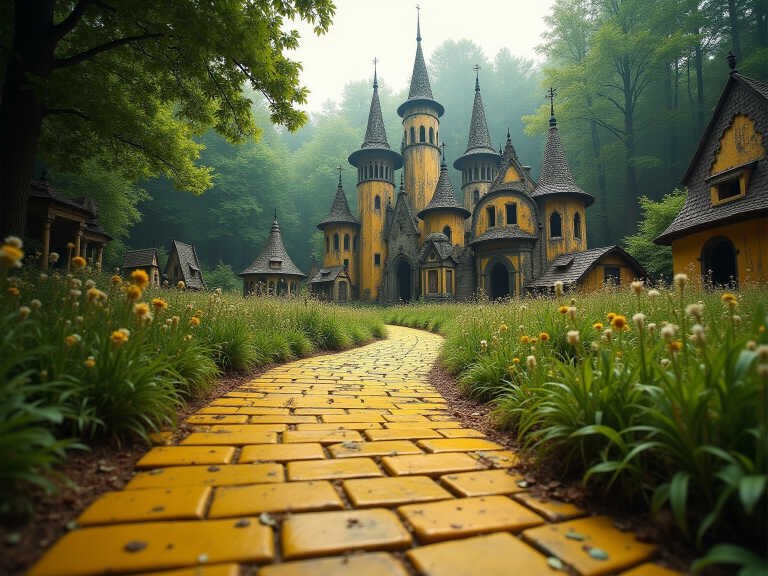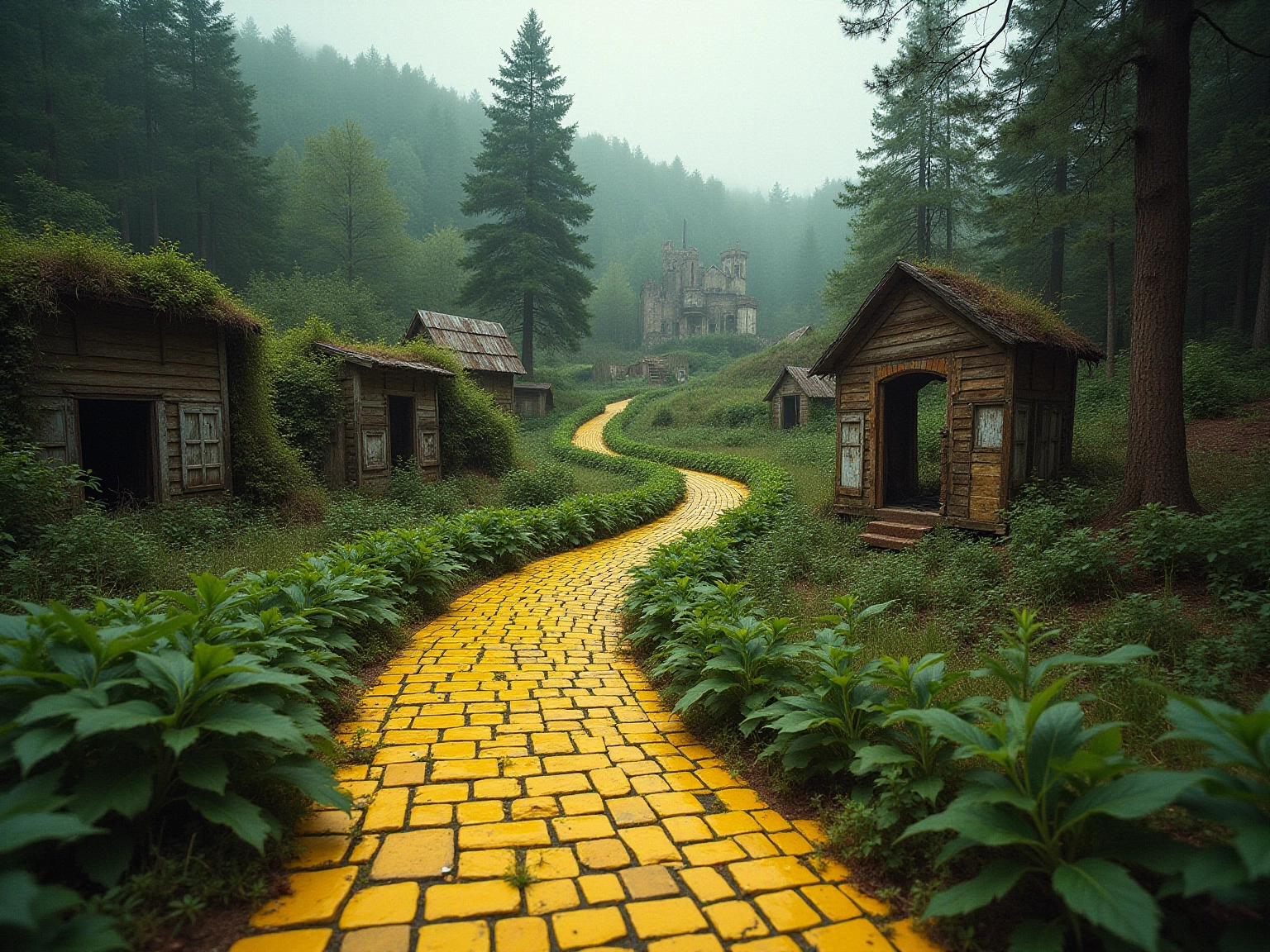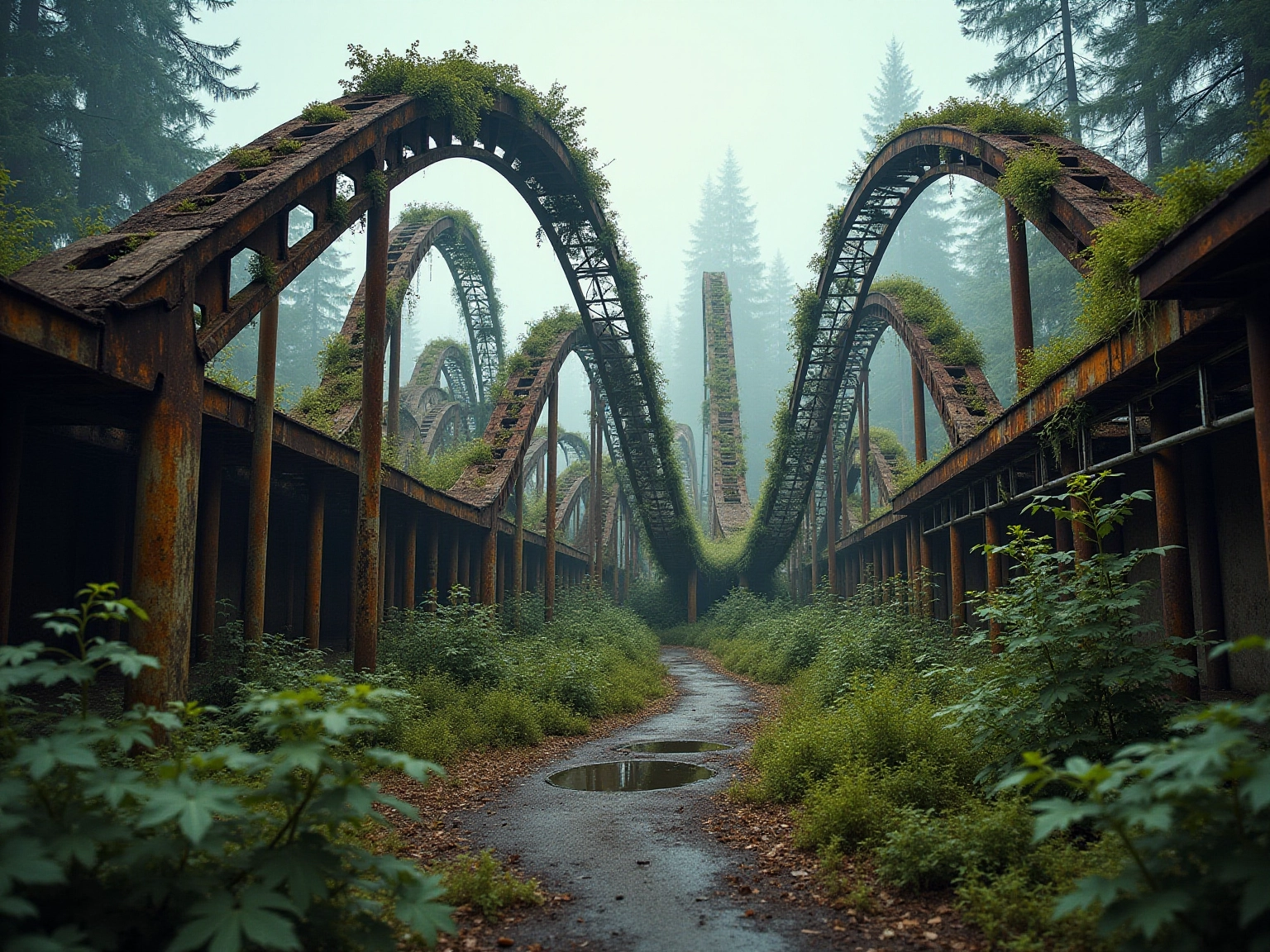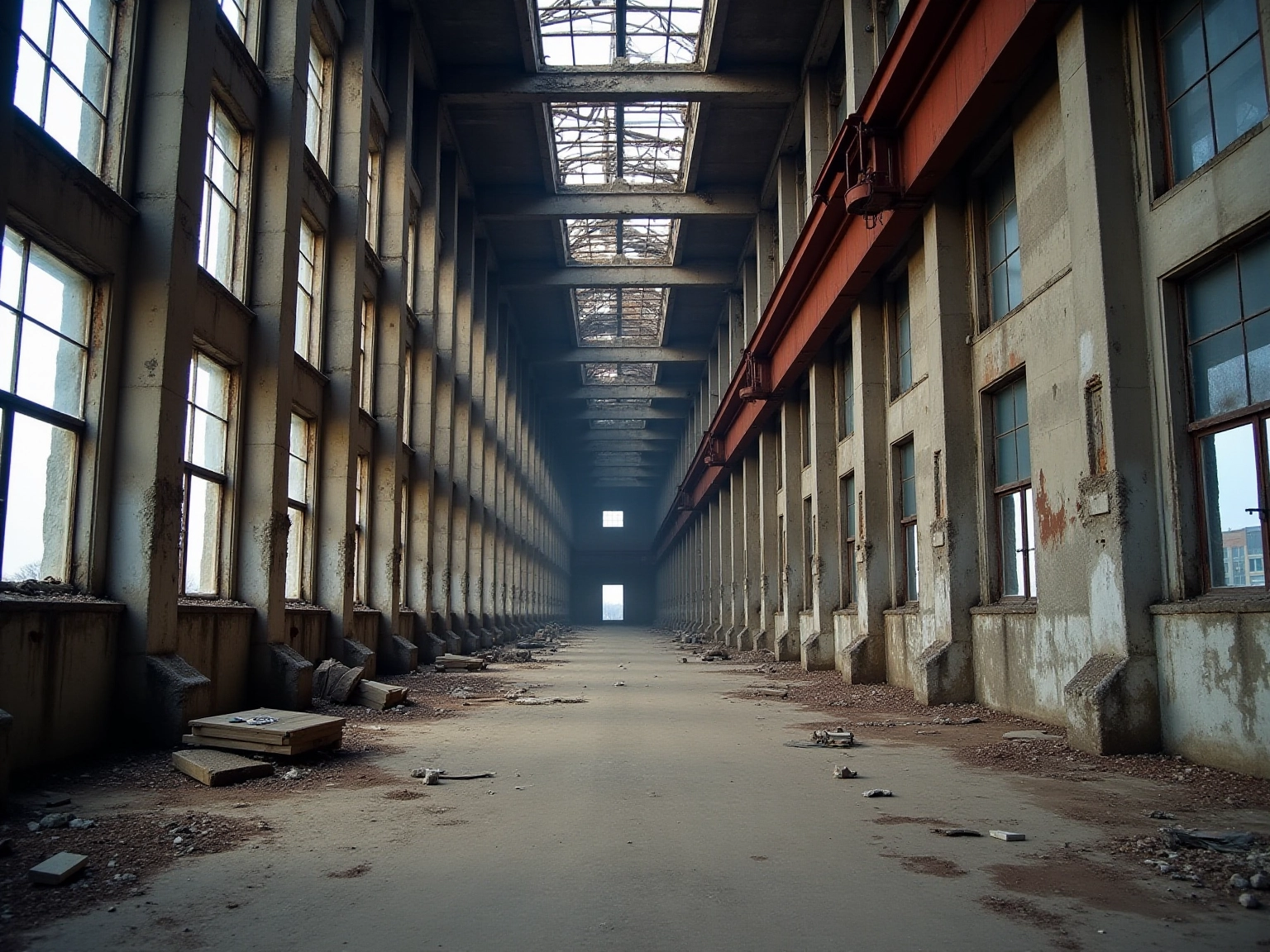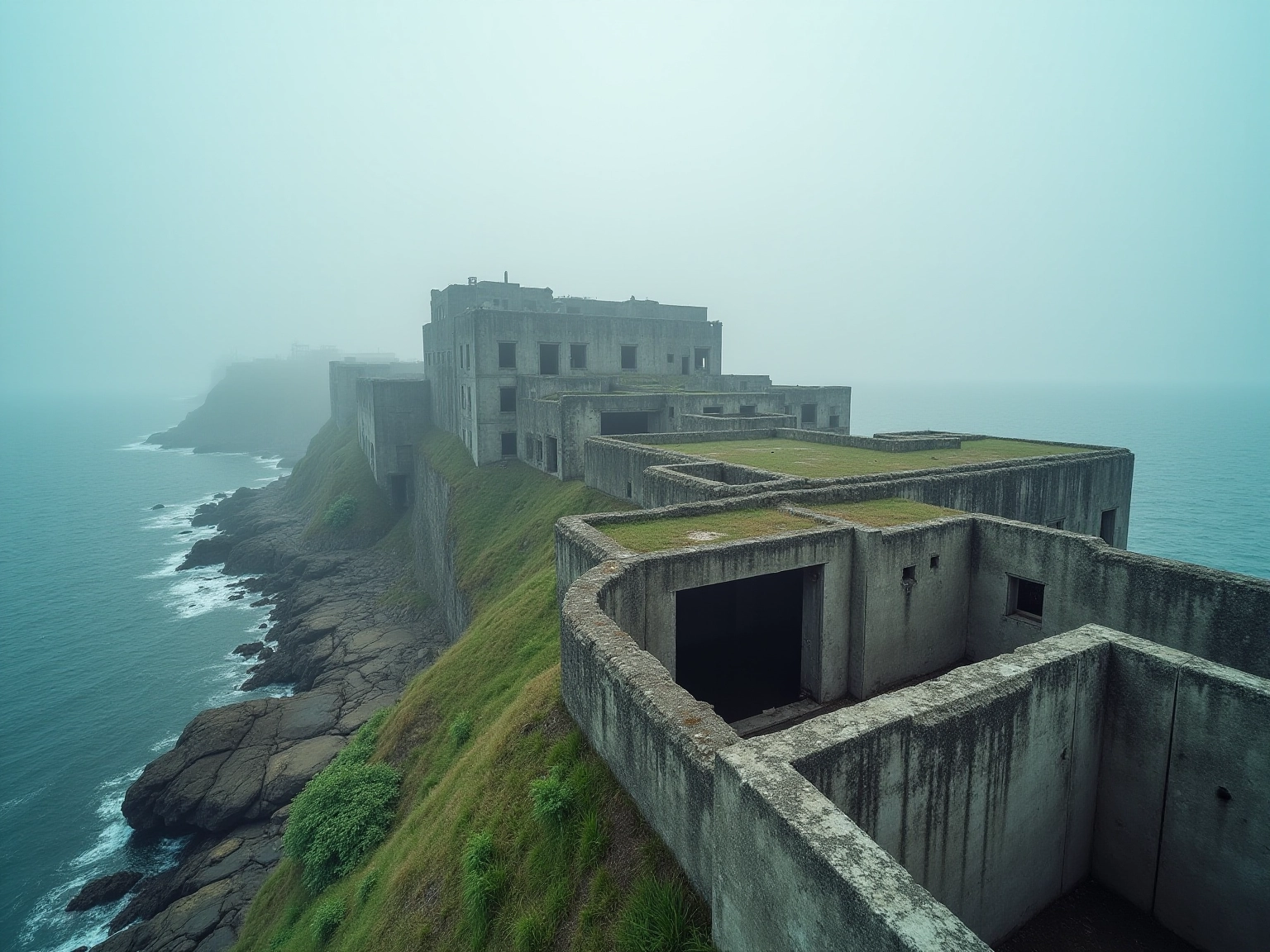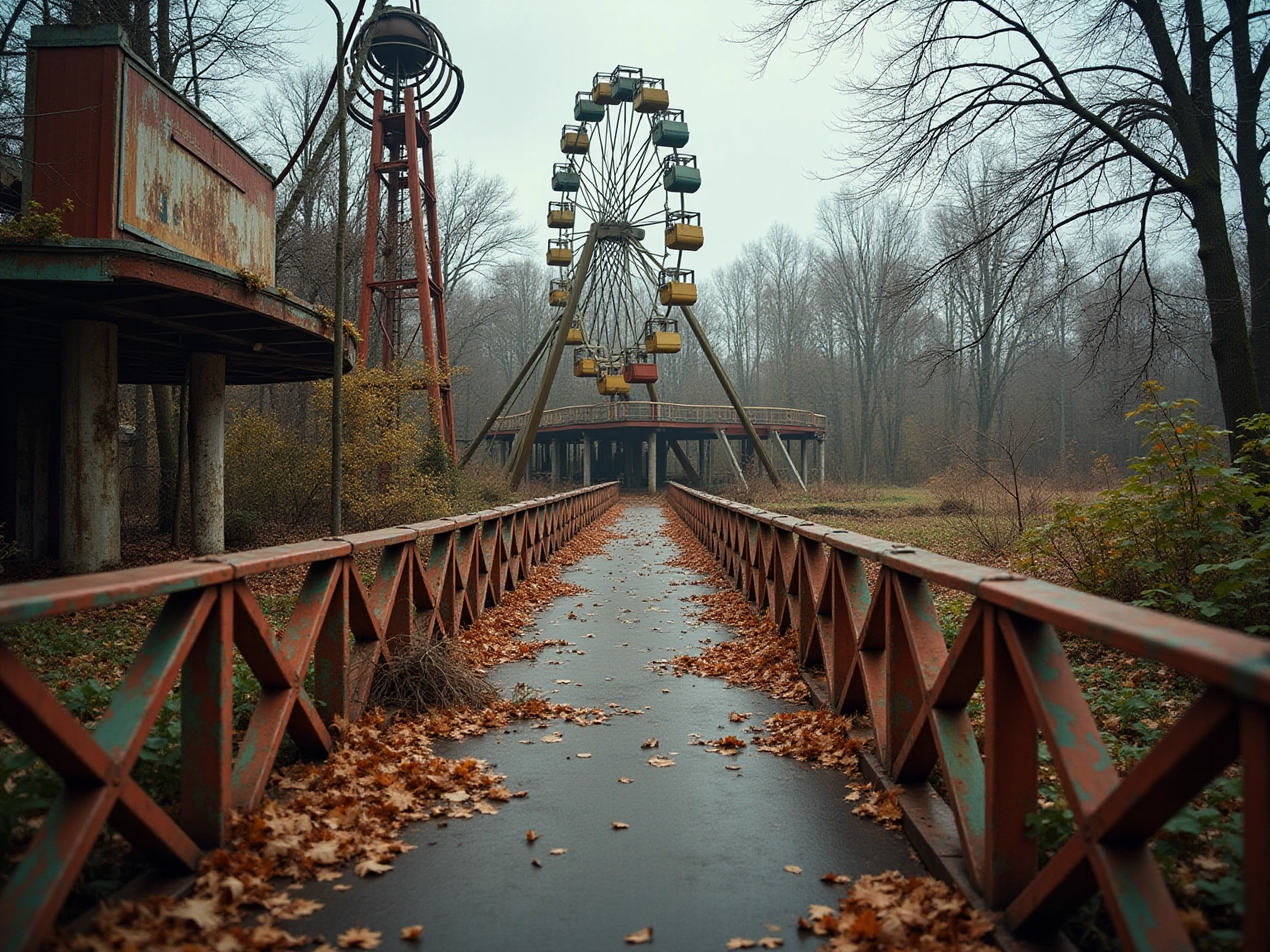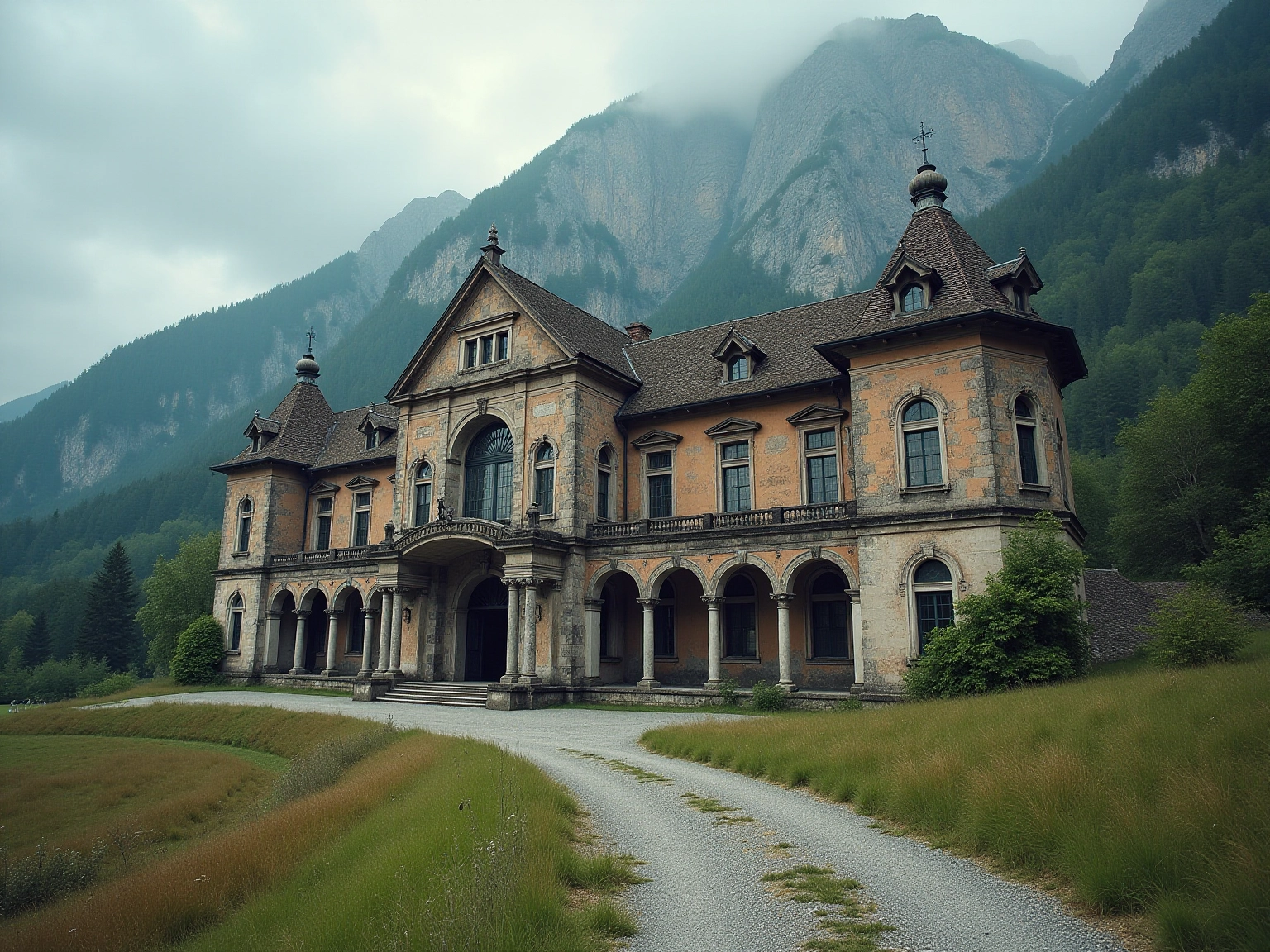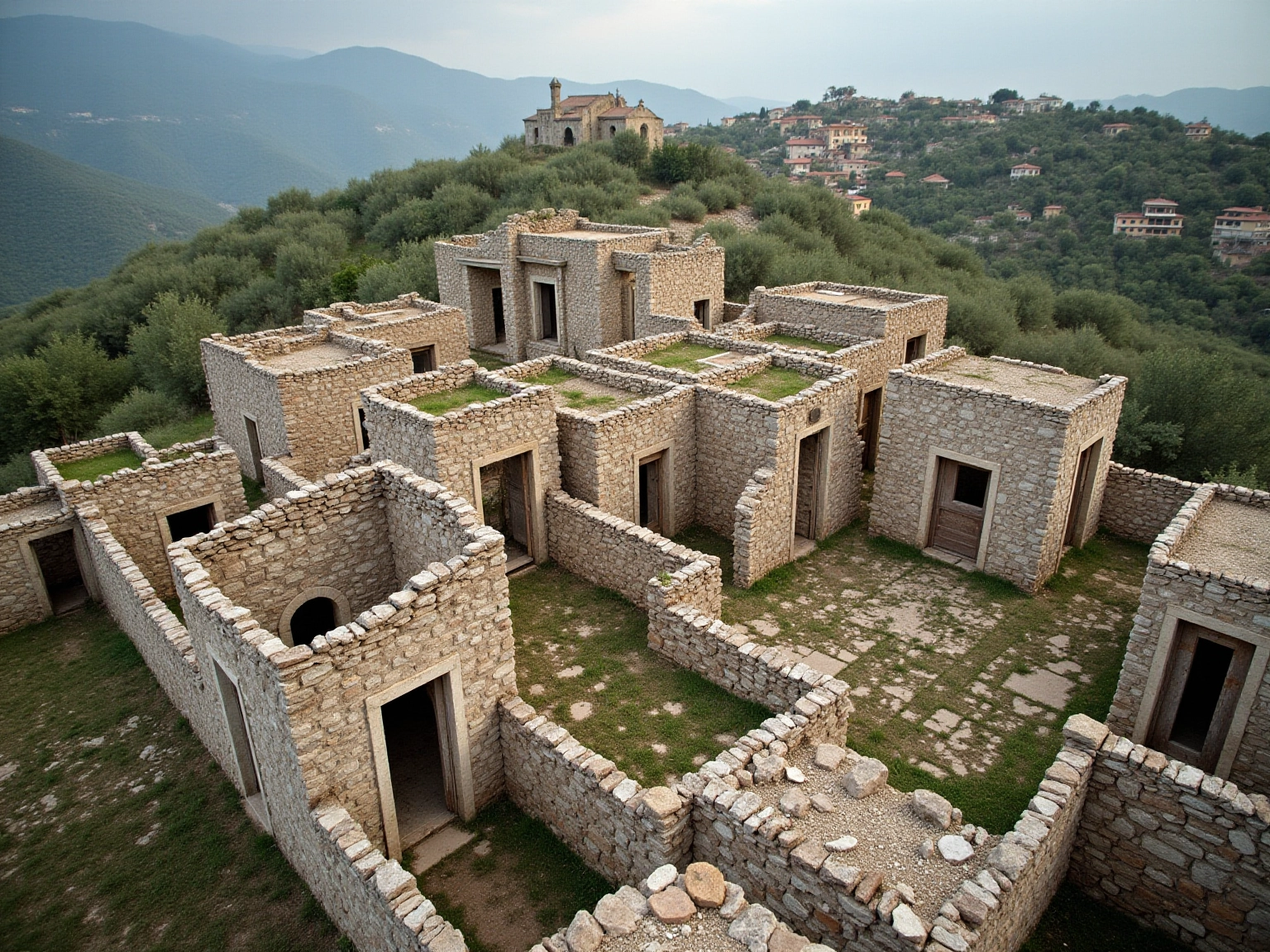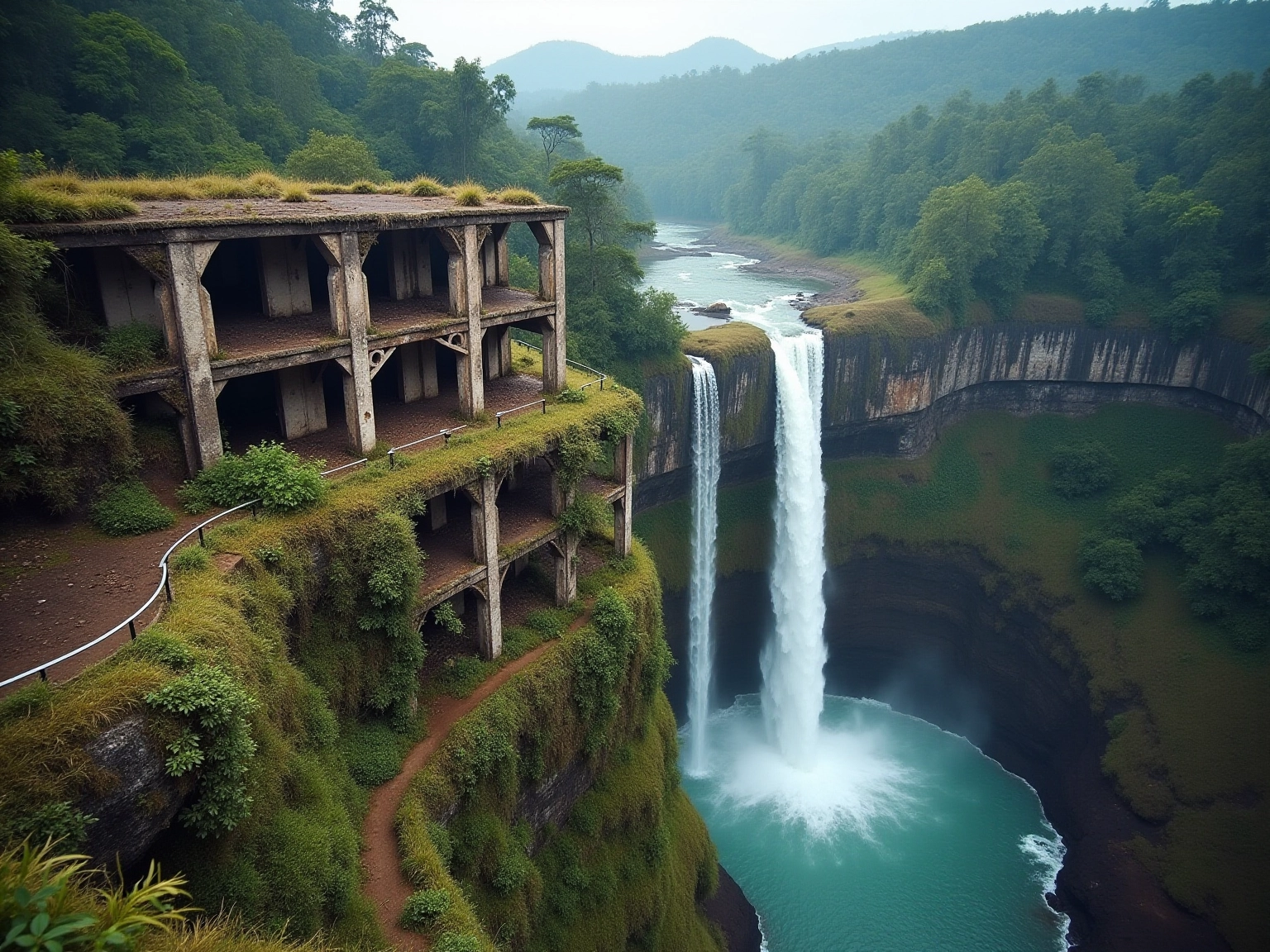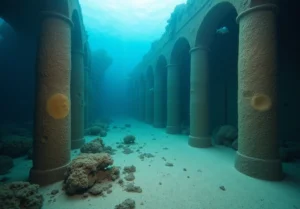Overview
This article invites you to explore ten abandoned parks and ghost towns, each with its own unique history and charm. From the whimsical Land of Oz in North Carolina to the hauntingly beautiful Hotel del Salto in Colombia, these locations serve as poignant reminders of past vibrancy and rich cultural narratives. Isn’t it fascinating how decay can evoke such nostalgia and curiosity about the stories these sites hold?
As you read on, picture the vibrant experiences awaiting you in these hidden gems. Imagine wandering through the remnants of places that once thrived, feeling the echoes of their past. Each site is a treasure trove of tales just waiting to be uncovered!
I can’t wait for you to discover how these abandoned spots can spark your imagination and sense of adventure. They remind us that every corner of the world has a story to tell, and sometimes, the most intriguing stories come from places we least expect. So, are you ready to dive into the allure of urban exploration? Let’s embark on this journey together!
Key Highlights:
- The Land of Oz in North Carolina, inspired by L. Frank Baum’s story, showcases attractions like the Yellow Brick Road and Emerald City but became abandoned after its closure in 1980.
- Six Flags New Orleans, originally Jazzland, closed after Hurricane Katrina in 2005, leaving behind rusting rides and attracting urban explorers.
- Pripyat, Ukraine, abandoned after the Chernobyl disaster in 1986, draws visitors interested in its haunting beauty and the stories of a lost community.
- The Packard Automotive Plant in Detroit symbolizes industrial decline and is part of revitalization efforts to transform it into an employment hub.
- Hashima Island in Japan, once a coal mining hub, is a ghost town that raises ethical questions about tourism and historical representation.
- Bodie, California, a ghost town from the gold rush era, is preserved as an abandoned park, attracting those interested in its historical narrative.
- Wonderland Amusement Park in Indiana, closed since the 1930s, embodies nostalgia and urban exploration, with its decaying rides captivating photographers.
- Canfranc International Railway Station in the Pyrenees is undergoing revitalization efforts to restore its historical significance and attract tourists.
- Kayaköy, Turkey, serves as an open-air museum reflecting on cultural exchanges and the impact of historical events on its architecture.
- Hotel del Salto in Colombia, once a luxury retreat, now stands as a haunted site with a museum highlighting its cultural and supernatural significance.
Introduction
Amidst the echoes of laughter and the thrill of adventure, abandoned amusement parks and ghost towns stand as haunting reminders of joy long past. From the enchanting Land of Oz in North Carolina to the eerie remnants of Six Flags New Orleans, these sites encapsulate the stories of human aspiration and the inevitable passage of time. Each location, whether it’s a forgotten village like Kayaköy or the decaying grandeur of Hotel del Salto, invites you to delve into the narratives woven into their crumbling structures.
As urban exploration gains momentum, these once-vibrant spaces are not just relics of history; they are poignant testaments to resilience, nostalgia, and the complex interplay between decay and beauty. This article embarks on a journey through some of the most captivating abandoned sites, revealing the rich tapestry of stories that continue to inspire and intrigue those who dare to wander through their shadows. Get ready to discover the magic that awaits in these forgotten places!
The Design Tourist: Explore the Enigmatic Land of Oz Theme Park
The Land of Oz, nestled in Beech Mountain, North Carolina, is a captivating theme destination inspired by L. Frank Baum’s beloved story. Since opening its doors in 1970, it has showcased enchanting attractions like the iconic Yellow Brick Road and the Emerald City. Can you imagine? At its peak in 1988, nearly 4,000 visitors entered its gates in a single day, a true testament to its popularity and the joy it brought to countless guests; however, after its closure in 1980, it turned into an abandon park, falling victim to the ravages of time and transforming into a hauntingly beautiful landscape filled with overgrown paths and crumbling structures.
This once-vibrant destination, often seen as an abandon park, now stands as a poignant reminder of childhood dreams and the fleeting nature of joy, captivating urban explorers and photographers eager to capture its ethereal charm. It’s not just its nostalgic significance but also the stories it tells about the passage of time and the memories it evokes. As Queen Ozma beautifully puts it, the distinction between material wealth and the riches of content highlights the inner peace and satisfaction that such places can inspire.
This makes the Land of Oz a must-visit for anyone intrigued by the intersection of history and design. So, are you ready to explore this magical place?
The Abandoned Six Flags New Orleans: A Ghostly Amusement Park Experience
Originally launched as Jazzland in 2000, Six Flags New Orleans quickly became a lively amusement destination, captivating guests with its thrilling rides and vibrant atmosphere. However, the devastation wrought by Hurricane Katrina in 2005 led to the park’s permanent closure, transforming it into an abandon park filled with haunting remnants of rusting roller coasters and abandoned attractions. Today, these remnants stand as eerie monuments to the joy that once filled the space, now gradually reclaimed by nature.
The site has transformed into a popular spot for urban explorers and photographers, drawn by the striking contrast between the decaying structures and the encroaching greenery. This juxtaposition not only highlights the passage of time but also serves as a poignant reminder of how natural disasters can impact human endeavors. In recent years, interest in the area has surged, with urban exploration enthusiasts documenting their adventures and sharing them across various platforms.
Visitor statistics after Katrina reveal a significant drop in tourism to the region, as the closure of this recreational area contributed to a broader narrative of urban decline in New Orleans. Urban exploration specialists note that places like Six Flags New Orleans offer unique insights into history, showcasing the interplay between architecture and nature while sparking conversations about the future of such locations. As former President George W. Bush reflected in his memoir, “I should have recognized the deficiencies sooner and intervened faster,” he acknowledged the government’s response to the disaster that impacted the city and its attractions.
As of 2025, the abandon park stands as a haunting yet captivating symbol of the resilience of both the city and its residents, captivating the imagination of those eager to uncover the stories hidden within its deserted attractions. Excitingly, a redevelopment firm has unveiled plans to revamp the area, aiming to complete the project in three to four years, which could signal a new chapter for this iconic location. This ongoing dialogue about urban decline and revitalization mirrors the situation of Burj Al Babas in Turkey, where abandoned buildings tell tales of ambition and financial struggles, inviting tourists and historians alike to explore the remnants of these once-thriving sites.
The Forgotten City of Pripyat: A Haunting Journey Through Chernobyl
Pripyat, Ukraine, was once a vibrant city bustling with life for the workers of the Chernobyl Nuclear Power Plant. However, everything changed with the catastrophic explosion in 1986, leading to a sudden evacuation. Now, the haunting landscape tells a poignant story of loss and resilience. As you wander through the remnants of abandoned buildings, schools, and the abandoned park, you’ll feel the echoes of a community frozen in time. This eerie beauty serves as a stark reminder of the disaster’s devastating impact on both human life and the environment, while also highlighting the strength of the Ukrainian spirit in the face of adversity.
What draws visitors to Pripyat is its ghostly charm—an irresistible pull for those eager to witness the remnants of a once-thriving society. Recent statistics reveal a growing interest in Chernobyl tourism, with a diverse mix of adventurers and culture enthusiasts among the visitors. Interestingly, younger travelers aged 18-35 are particularly attracted to this unique blend of exploration and history. As the Ukrainian government promotes the Chernobyl Exclusion Zone as a tourist destination, hopes are high for creating a ‘green corridor’ that ensures safer access while preserving the area’s historical significance. Mariana Oleskiv, the leader of the State Agency for Tourism Development, has expressed optimism for the future of tourism in Chernobyl, acknowledging the importance of the recent conflict’s history while celebrating the resilience of the region.
Exploring Pripyat offers a unique chance to connect with the past, as each location tells the stories of lives once lived there. The area of the abandoned park, with its rusting rides and overgrown pathways, stands as a poignant symbol of the joy that was lost. Visitors often leave with a deeper appreciation for the cultural narratives that shape our understanding of such tragedies. Pripyat is not just a ghost town; it’s a testament to resilience and remembrance. This approach to storytelling aligns beautifully with Karen LeBlanc’s insights featured in The Design Tourist, where she emphasizes creativity and connection. It enhances our appreciation for the cultural narratives that define these significant locations. As Karen often points out, the design features within these abandoned parks—from the structure of the amusement park to the traces of daily life—serve as powerful reminders of history, encouraging a deeper connection to the narratives they convey.
The Ruins of the Detroit Packard Plant: A Testament to Industrial Decline
The Packard Automotive Plant in Detroit, once a shining example of American manufacturing, now stands as a haunting reminder of industrial decline. Since its closure in 1956, this iconic site has fallen into decay, with crumbling walls and rusting machinery telling the tale of a once-thriving industry. If you’re drawn to urban exploration, this location is a must-see! Its vast, deteriorating structures are not just visually striking; they also serve as poignant reminders of the fleeting nature of progress and the economic shifts that have left deep scars on the landscape.
Recently, there’s been a buzz about the Packard Plant‘s role in Detroit’s recovery efforts. Mayor Mike Duggan has unveiled plans to transform this space into a dynamic employment hub in the next couple of years! This initiative underscores the ongoing impact of industrial downturns on tourism and local economies, as the ruins continue to draw those intrigued by the stories woven into their walls. It’s often said that “no country is ever successful in the long term without a really strong and vibrant manufacturing base,” which highlights the historical importance of the Packard Plant in Detroit’s economic narrative.
The Packard Plant is a fascinating case study in American manufacturing, illustrating broader trends in urban exploration and the cultural significance of such sites. As you wander through its remnants, you’ll engage with a narrative that reflects both the glory and the challenges of Detroit’s industrial past. James Dyson once said, “We always want to create something new out of nothing… there is only dogged persistence—and in the end you make it look like a quantum leap.” This sentiment truly resonates with the ongoing efforts to breathe new life into the Packard Plant, making it a compelling destination for anyone eager to understand the complexities of urban decay and renewal.
The Abandoned Island of Hashima: A Japanese Ghost Town of the Sea
Have you ever heard of Hashima Island, also known as Gunkanjima or Battleship Island? It’s a strikingly desolate place off the coast of Nagasaki, Japan, that tells a fascinating story. Once a bustling coal mining hub, this island was home to thousands of workers until the mines closed in 1974. Today, it stands as a haunting silhouette against the sea, with decaying concrete structures and nature reclaiming its space.
Visiting this ghost town is like stepping back in time, reminding us of Japan’s rapid industrialization and the decline of its coal industry. The remnants of Hashima’s past narrate a tale of both progress and loss, drawing in adventurers and history buffs eager to explore its eerie landscape.
In recent years, Hashima has become a tourist hotspot, with operators like Gunkanjima Concierge offering guided tours. But here’s the catch: access to the island is limited due to safety concerns. This raises some ethical questions about how we portray its more troubling past, especially the forced labor that occurred during its operational years. Critics argue that the Japanese government seems to prioritize tourism revenue over preserving Hashima’s historical integrity. As Japan’s Prime Minister Tomiichi Murayama pointed out, there was “tremendous damage and suffering to the people of many countries, particularly to those of Asian nations” due to Japan’s colonial rule, highlighting the ethical implications of tourism on Hashima Island.
As we look ahead to 2025, the island’s dilapidated structures remain largely intact, but the General Office of the mine is now in ruins, symbolizing a once-thriving community that has been largely forgotten. It’s a bit sad, really, how the commodification of Hashima as a tourist attraction often overshadows its historical significance. This brings up interesting discussions about the symbolism of abandoned park places in Japan and the impact of industrialization on ghost towns. Exploring Hashima Island offers a unique glimpse into the complexities of cultural history, making it a compelling destination for anyone curious about the narratives behind these enigmatic sites. So, are you ready to dive into this adventure?
The Abandoned Ghost Town of Bodie: A Step Back in Time
The Abandoned Ghost Town of Bodie: A Step Back in Time
Bodie, California, is such an extraordinary place! It stands as a vibrant symbol of the Wild West’s mining era, telling stories through its preserved buildings and hauntingly beautiful scenery. Established in 1859, this ghost town thrived during the gold rush, reaching a peak population of nearly 8,000 residents. But as the gold dwindled by the late 1800s, Bodie faced the reality of becoming an abandon park, leaving behind a landscape that whispers tales of resilience and nostalgia. By 1910, only 698 residents remained, mostly families who chose to stay. Today, Bodie is preserved as an abandon park, allowing visitors to stroll through its dusty streets and explore the remnants of its lively past, all kept in a state of ‘arrested decay.’ The eerie atmosphere, described by a visitor in 1881 as a ‘sea of sin, lashed by the tempests of lust and passion,’ combined with its historic buildings, creates a captivating experience for ghost town enthusiasts and design lovers alike.
In 2025, Bodie continues to draw visitors, showcasing the lasting allure of California’s ghost towns and the importance of preserving cultural heritage. Recent tourism trends show a growing interest in ghost towns, making Bodie a must-visit for anyone looking to connect with the past through its unique design and aesthetic charm. This immersive exploration reflects the insights of Karen LeBlanc, travel host of The Design Tourist, who believes that every destination has a story to tell through its art and culture. So, are you ready to uncover the secrets of Bodie? Let’s dive into this adventure together!
The Abandoned Wonderland Amusement Park: A Surreal Exploration
Wonderland Amusement Park, nestled in Indianapolis, Indiana, was once a lively hub for families seeking entertainment and adventure! Founded in the early 1900s, this amusement area featured a variety of rides, games, and attractions that fascinated guests for generations. But, after its closure in the 1930s, it began a slow decline into an abandon park, transforming into a surreal landscape marked by rusting rides and overgrown pathways. Today, urban explorers are irresistibly drawn to its haunting beauty, capturing the poignant contrast between joy and decay that defines this forgotten amusement park.
The cultural significance of Wonderland Amusement Park goes beyond its physical remnants; it embodies a nostalgic connection to a bygone era of family fun. As urban exploration gains popularity, photographers and adventurers alike are documenting the area’s eerie charm, celebrating the artistry found in decay. Recent updates show that the abandon park continues to spark interest among enthusiasts who share their experiences and insights on social media platforms. The effect of decay on the landscape of Wonderland is profound, turning once-vibrant attractions into poignant reminders of the past. This transformation invites you to reflect on the stories behind each rusted ride and crumbling structure in the abandon park, fostering a deeper appreciation for the cultural narratives that these abandoned spaces hold. The amusement venues market, valued significantly in terms of revenues from goods and services, underscores the importance of such spaces in the broader context of entertainment and urban exploration.
Insights from the ‘Regional Attendance Insights’ case study highlight trends and preferences among amusement venue visitors, further emphasizing the cultural significance of Wonderland Amusement Park and its appeal to urban explorers. As you explore the remnants of Wonderland, you not only uncover its history but also engage with the emotions and memories it evokes. It’s a compelling destination for those seeking to connect with the past through the lens of urban exploration. After all, at an amusement park, there’s never a dull moment; it’s a place where the fun never ends!
The Abandoned Train Station of Canfranc: A Hidden Gem of Architecture
Nestled in the breathtaking Pyrenees between Spain and France, Canfranc International Railway Station is a gem just waiting to be discovered! Inaugurated in 1928, this striking transportation hub was designed with stunning Beaux-Arts architecture, showcasing the grandeur of early 20th-century design. However, the station’s story took a dramatic turn after a train derailment in 1970, which contributed to its gradual decline and eventual status as an abandoned park. Today, Canfranc stands as a hauntingly beautiful ruin, captivating visitors and photographers alike with its architectural splendor and the rich narratives embedded within its crumbling walls.
Excitingly, recent efforts to revitalize the station are underway! The goal? To restore its former glory and attract a new wave of tourists. As renovation plans progress, officials are optimistic about enhancing visitor experiences and promoting the cultural heritage of this iconic site. Ramón Javier Campo Fraile, an acclaimed writer, noted, “This project […] will promote tourism to the place where thousands of people were saved when fleeing the horrors of war, and where various channels of espionage helped the allies to victory.” This perspective really highlights the station’s historical significance and its potential impact on tourism.
The architectural significance of Canfranc is deeply intertwined with its historical context. Once a vital link in European transportation, it facilitated connections across borders. The Somport pass, located at 1,640 meters above sea level, adds geographical context to the station’s importance in the Pyrenees region.
But the charm of Canfranc goes beyond its visual appeal; it symbolizes resilience and the past. As you discover this concealed treasure, take a moment to contemplate the tales of those who once walked its platforms. It’s truly a must-see location for design lovers and enthusiasts of history alike! This exploration resonates with Karen LeBlanc’s insights on the importance of authenticity and creativity in travel, encouraging you to engage deeply with the narratives of places like Canfranc. Plus, the rising trend of architectural tourism associated with deserted locations emphasizes our growing fascination with places where the past and design beautifully intersect.
The Abandoned Village of Kayaköy: A Ghost Town in Turkey
Kayaköy, nestled in southwestern Turkey, is an evocative ghost town that tells the story of a once-vibrant community. Originally home to Greek residents, this village became an abandon park in the early 1920s due to the Greco-Turkish War. Today, Kayaköy serves as a poignant open-air museum, showcasing crumbling stone houses and churches that stand as testaments to its rich history. When you wander through the remnants of this village, you can reflect on the cultural exchanges that have shaped its identity over the decades.
The architectural layout of Kayaköy is particularly noteworthy! The village was intentionally designed so that no building obstructed another’s sunlight—a principle that speaks to the harmonious coexistence of its former inhabitants. This distinctive feature not only enhances the visual appeal but also offers insight into the community’s values and way of life. It’s fascinating to see how these intentional design concepts echo in contemporary architecture, which emphasizes light and space.
As a spot for cultural heritage tourism, Kayaköy draws visitors eager to connect with its historical significance. There’s a growing interest in abandoned villages like Kayaköy, with statistics showing an increase in visitors who are curious to explore the narratives of human migration and memory embedded within its walls. Ongoing preservation efforts aim to maintain the integrity of this ghost town, ensuring that its stories continue to resonate with future generations. Admission to this abandon park is just five Turkish lira, and you’ll find a ticket booth conveniently located beside the Lower Church. In 2025, Kayaköy remains a vital case study in exploring abandon parks, illustrating the complexities of cultural heritage and the importance of preserving such sites for educational and reflective purposes. The village not only provides a glimpse into the past but also serves as a reminder of the intricate tapestry of human experiences that shape our collective narrative. It echoes the sentiments of contemporary design that honors and reflects upon the past while influencing the future. So, why not plan a visit and immerse yourself in this captivating history?
The Abandoned Hotel del Salto: A Haunted Retreat Overlooking a Waterfall
Nestled dramatically on the edge of Tequendama Falls in Colombia, Hotel del Salto opened its doors in 1928 as a luxurious escape for the elite. Imagine stunning views and lavish accommodations drawing in guests eager to unwind in nature’s embrace! Yet, as time passed, the hotel closed in the early 1990s, succumbing to neglect and a haunting legacy filled with tragic tales and ghostly sightings. Today, its crumbling structure and wild gardens evoke a haunting beauty that captivates thrill-seekers and paranormal enthusiasts alike.
The hotel’s eerie reputation is amplified by the striking contrast between its former glory and its present decay. Guests have reported spectral apparitions and unsettling atmospheres, making it a hotspot for those curious about the supernatural. Beyond its architectural allure, Hotel del Salto carries cultural significance, embodying stories of loss and despair that linger within its walls. As Robert Curran poignantly notes, “The haunted are trapped in a cycle of fear and despair, unable to break free from their torment,” which really underscores the emotional weight of the narratives tied to this fascinating place.
Excitingly, recent updates reveal that the site is now home to the Tequendama Falls Museum of Biodiversity and Culture. This initiative aims to preserve the area’s rich heritage while addressing the haunting stories that remain. It’s a wonderful transformation that reflects the growing trend in paranormal tourism—where places like Hotel del Salto serve as both historical landmarks and intriguing sites for ghostly exploration. Visitor statistics show a rising interest in the museum, highlighting its role in drawing in those fascinated by the supernatural.
The haunting atmosphere of Hotel del Salto has even inspired various artistic interpretations, such as the novel ‘Bochica’ by Flórez-Cerchiaro. This captivating story delves into themes of isolation and past trauma through its protagonist’s return to a childhood home reminiscent of the hotel, weaving supernatural elements with the painful legacies of beautiful places. It’s a connection that prompts deeper reflection on the struggles faced by those who inhabit such spaces.
As interest in haunted locations continues to grow, Hotel del Salto stands as a poignant reminder of the intersection between beauty, history, and the spectral stories that haunt our past. So, are you ready to explore this captivating blend of nature and mystery?
Conclusion
Abandoned amusement parks and ghost towns are such compelling reminders of the joy and vibrancy they once held! They’ve transformed into haunting landscapes that evoke nostalgia and reflection. Just think about the magical remnants of the Land of Oz in North Carolina or the eerie decay of Six Flags New Orleans—each site tells a unique story of human aspiration and the relentless passage of time. It’s fascinating how these locations highlight the interplay between decay and beauty, capturing the imagination of urban explorers and photographers alike.
As you journey through these abandoned spaces, you’ll uncover not only the architectural and historical significance of each site but also the resilience of communities impacted by change. For instance, Pripyat stands as a testament to the human cost of disaster, while the Packard Plant in Detroit reflects broader trends of industrial decline and renewal. Each ghost town narrates a tale of loss, resilience, and the cultural identities that shaped them, inviting you to engage with the past and consider the lessons it imparts.
With the growing interest in urban exploration and cultural heritage tourism, these forgotten places offer a unique opportunity to connect with history and reflect on the complexities of human experiences. By preserving these sites, we acknowledge the layered narratives they embody, ensuring that the stories of joy, tragedy, and resilience continue to resonate with future generations. The allure of abandoned spaces lies not just in their decay but in the profound connections they forge with our shared history, reminding us of the beauty that can emerge, even from the shadows.
Frequently Asked Questions
What is the Land of Oz and where is it located?
The Land of Oz is a theme destination inspired by L. Frank Baum’s story, located in Beech Mountain, North Carolina.
When did the Land of Oz open and what attractions did it feature?
The Land of Oz opened in 1970 and featured attractions such as the iconic Yellow Brick Road and the Emerald City.
What was the peak visitor count for the Land of Oz and when did it occur?
The peak visitor count for the Land of Oz occurred in 1988, with nearly 4,000 visitors entering its gates in a single day.
What happened to the Land of Oz after it closed in 1980?
After its closure in 1980, the Land of Oz became an abandoned park, succumbing to the effects of time, leading to overgrown paths and crumbling structures.
Why is the Land of Oz considered a poignant reminder of childhood dreams?
The Land of Oz serves as a poignant reminder of childhood dreams due to its nostalgic significance and the stories it tells about the passage of time and memories.
What does Queen Ozma’s quote highlight about the Land of Oz?
Queen Ozma’s quote highlights the distinction between material wealth and the inner peace and satisfaction that places like the Land of Oz can inspire.
Why is the Land of Oz a popular destination for urban explorers and photographers?
The Land of Oz is popular among urban explorers and photographers for its hauntingly beautiful landscape and the ethereal charm of its abandoned structures.
What was Six Flags New Orleans originally known as and when did it open?
Six Flags New Orleans was originally known as Jazzland and opened in 2000.
What led to the permanent closure of Six Flags New Orleans?
The permanent closure of Six Flags New Orleans was caused by the devastation of Hurricane Katrina in 2005.
How has Six Flags New Orleans transformed since its closure?
Since its closure, Six Flags New Orleans has become an abandoned park filled with rusting roller coasters and attractions, gradually reclaimed by nature.
What has sparked interest in urban exploration at Six Flags New Orleans?
The striking contrast between decaying structures and encroaching greenery has drawn urban explorers and photographers to Six Flags New Orleans.
What are the implications of the closure of Six Flags New Orleans on tourism?
The closure of Six Flags New Orleans contributed to a significant drop in tourism in the region, reflecting a broader narrative of urban decline in New Orleans.
What future plans exist for the Six Flags New Orleans site?
A redevelopment firm has unveiled plans to revamp the area, aiming to complete the project in three to four years.
What was Pripyat, Ukraine, and what event led to its current state?
Pripyat was once a vibrant city for workers of the Chernobyl Nuclear Power Plant, but it became abandoned following the catastrophic explosion in 1986.
What draws visitors to Pripyat today?
Visitors are drawn to Pripyat for its ghostly charm and the opportunity to witness the remnants of a once-thriving society.
How is the Ukrainian government promoting tourism in Chernobyl?
The Ukrainian government is promoting the Chernobyl Exclusion Zone as a tourist destination, with hopes of creating a ‘green corridor’ for safer access.
What does exploring Pripyat offer to visitors?
Exploring Pripyat offers visitors a chance to connect with the past and appreciate the cultural narratives that shape our understanding of the disaster’s impact.
How do the design features of abandoned parks contribute to storytelling?
The design features within abandoned parks serve as powerful reminders of history, enhancing our connection to the narratives they convey.








